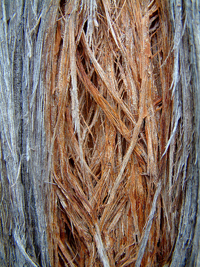Life Cycle is a series of posts on the extraordinary lives of everyday things.

Ah, the daily rag. Where coffee revives and cigarettes embolden, newspapers round out the holy breakfast trinity, infusing us with knowledge, blackening our fingertips as though they've touched the fires of wisdom.
(OK, it's just newsprint. But we journalists tend to get excited about it.)
Folks like you probably read the Gray Lady (and, of course, Lady HuffPo) on the Internet. Yet, more than 50 million newspapers hit stands and porches every morning in this country (double that in China).
If you're like Sarah, you get the scoop from web sources around the clock but continue a love affair with the printed word. (Simran sticks to the e-word not only because it's greener but because she's cheap and most e-news is free. By "greener" we don't mean impact-free.) To read the news is good, Sarah says, but to hold it in one's hands is divine. Over breakfast, on the train, at the coffee shop--the tactile newspaper experience is one that many would be remiss to give up.
(By now, you might realize here is where we insert some overwhelming, perhaps depressing information. One reader recently posted a comment to that effect, yearning for tips on how to lead a greener life. We hear you, man, but view our task as solidifying what, for most people, is a vague grip on the environmental domino effect of mass consumption and delineating a host of questions you can ask yourself in order to be a more conscious consumer).
So, newspaper subscriber, when she is delivered to your door, pick up your inky friend and ponder her amazing journey:
A tree falls. Many trees, really--200 million per year, just for newspapers. These aren't ancient rainforest trees but rather young, fast-growing woods, such as the eucalyptus pictured above, planted for the purpose of harvesting (often replacing native eco-systems).
The trees are transported to a paper mill for cleaning and pulping, a 150-year-old process involving heat and a lot of grinding. The pulp is washed, bleached and literally goes through the ringer. The resultant waste winds up in landfills or your local bodies of water. The entire process of refining trees into smooth, lightweight paper comes at a high energy cost and produces serious carbon dioxide emissions (that contribute to global climate change).
Finally, the paper is baled, transported and stored until a newspaper press covers it in black carbon ink.
The fair newspaper consumer then does or doesn't read the pages, and then does or doesn't recycle them.
Happily, the EPA reports that 88% of newspapers are recycled--a high-energy process (transporting, de-inking, re-bleaching, shredding, pulping) but certainly preferable to altogether junking them. Newspapers still comprise 6.3% (13.1 million tons, about a fifth of which is pesky ad inserts) of our solid waste, with paper products in general accounting for more than a third of our total waste stream.
According to the Environmental Defense's online "paper calculator," 2,600 Sunday papers (say, to supply a town of 10,000 where one in four residents reads the paper) taxes Planet Earth 16 trees, 54 million energy BTUs (enough to power your home for 6 months), 10,135 pounds of carbon emissions (a year's worth for most cars), 27,562 gallons of water and 3,434 pounds of solid waste.
Those numbers are assuming the paper has 50% recycled content, which is mandated or voluntarily adopted by about half of the country. Such state mandates, along with local recycling efforts, more eco-friendly ink resources, tougher (though inadequate) government standards on waste dumping and other efforts have made progress toward cleaning up the newspaper publishing biz. And the longtime downturn in circulation, while a conundrum for the industry, is good news for the environment.
So, what can be done at the personal level, aside from relying solely on web versions of your must-reads? A while back, Sarah decreased her newspaper delivery from daily to weekends-only--her employer gets a paper delivered, easily providing a weekday fix for the whole office. At home, she doesn't waver on recycling newspaper and makes sure to suspend delivery service when going out of town. Simran reads it online and borrows the hard copy from her neighbor when she needs a paper fix.
What about you? We'd love to know who here still "takes the paper."
Next up: Toilets, toilet paper and asses who love them.
This post was written by Sarah Smarsh and Simran Sethi. Thanks to the University of Kansas School of Journalism and Lacey Johnston for research assistance. Eucalyptus photo courtesy of Tony from Sydney.